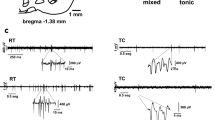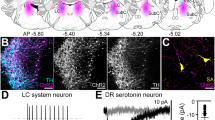Abstract
The nucleus tractus solitarius (nTS) is an important site for the integration of visceral information and its modification by afferent neural systems. One such afferent system arises from the raphe nuclei. This study investigated the electrophysiological effects of the primary transmitter of the raphe nuclei, serotonin (5-HT), on neurones in the nTS of the rat. Extracellular single unit recordings were made of the spontaneous activity of nTS neurones in isolated, superfused brainstem slices during bath-application of 5-HT (50, 100, 250, 500, 1000 nM). Twenty-seven of 46 neurones studied (≈90%) showed concentration-dependent decreases of firing rate, with a calculated EC50 of 261 nM. An additional 3 neurones displayed excitatory responses, while the remaining 16 were unaffected. The broad-spectrum 5-HT1 antagonist methysergide (200 nM) was highly effective in producing blockade of 5-HT-evoked depressions of neuronal activity (4 of 4), whereas the 5-HT1A receptor-selective antagonist spiroxatrine (5 nM) and the 5-HT2-selective antagonist mianserin (200 nM) were considerably less effective (1 of 5 and 2 of 5, respectively). Seven additional neurones were examined during exposure to the 5-HT1-selective agonist 5-carboxamidotryptamine (5-CT) or the 5-HT2-selective agonist DOI. 5-CT depressed the activity of three of the four neurones tested, the remaining neurone being unresponsive at concentrations up to 50 nM. DOI at concentrations up to 100 nM failed to affect the activity of two of the three neurones tested, and depressed the activity of the third at a concentration of 50 nM. These data provide electrophysiological evidence of the presence of 5-HT, serotonergic receptors in the nTS, and suggest that 5-HT primarily has a depressent effect on the activity of individual neurones in the nTS.
Similar content being viewed by others
References
Adham N, Kao HT, Schechter LE, Bard J, Olsen M, Urquhart D, Durkin M, Hartig PR, Weinshank RL, Branchek TA (1993) Cloning of another human serotonin receptor (5-HT1F): a fifth 5-HT1 receptor subtype coupled to the inhibition of adenylate cyclase. Proc Nat Acad Sci USA 90:408–412
Appel NM, Mitchell WM, Garlick RK, Glennon RA, Titeler M, De Souza EB (1990) Autoradiographic characterization of (±)-1-(2,5dimethoxy-4-[125I]iodophenyl)-2-aminopropane ([125I1]DOI) binding to 5-HT2 and 5-HT1C receptors in rat brain. J Pharmacol Exp Ther 255:843–857
Barrett JE, Hoffmann SM, Olmstead JN, Foust MJ, Harrod C, Weissman BA (1989) Behavioral and neurochemical effects of the serotonin (5-HT)1A receptor ligand spiroxatrine. Psychopharmacology 97:319–325
Bobillier P, Seguin S, Petitjean F, Salvert D, Touret M, Jouvet M (1976) The raphe nuclei of the cat brainstem: a topographical atlas of their efferent projections as revealed by autoradiography. Brain Res 113:449–486
Calzà L, Giardino L, Grimaldi R, Rigoli M, Steinbusch HWM, Tiengo M (1985) Presence of 5-HT-positive neurons in the medial nuclei of the solitary tract. Brain Res 347:135–139
Carter DA, Lightman SL (1985) Cardio-respiratory actions of substance P, TRH and 5-HT in the nucleus tractus solitarius of rats: evidence for functional interactions of neuropeptides and amine neurotransmitters. Neuropeptides 6:425–436
Davies M, Wilkinson LS, Roberts MHT (1988) Evidence for excitatory 5-HT2-receptors on rat brainstem neurones. Br J Pharmacol 94:483–491
Dedeoglu A, Fisher LA (1991a) Central nervous actions of serotonin and a serotonin1A receptor agonist: cardiovascular excitation at low doses. J Pharmacol Exp Ther 257:425–432
Dedeoglu A, Fisher LA (1991b) Central and peripheral injections of the 5-HT2 agonist, 1-(2,5-dimethoxy-4-iodophenyl)-2-aminopropane, modify cardiovascular function through different mechanisms. J Pharmacol Exp Ther 259:1027–1034
Fagni L, Dumuis A, Sebben M, Bockaert JG (1992) The 5-HT4 receptor subtype inhibits K+ current in colliculi neurones via activation of a cyclic AMP-dependent protein kinase. Br J Pharmacol 105: 973–979
Feldman PD, Felder RB (1988) Compatibility of urethane sedation with studies of adrenergic systems in the rat brain slice. J Neurosci Meth 24:189
Feldman PD, Felder RB (1989a) α2-Adrenergic modulation of synaptic excitability in the rat nucleus tractus solitarius. Brain Res 480: 190–197
Feldman PD, Felder RB (1989b) α-Adrenergic influences on neuronal responses to visceral sensory input in the nucleus tractus solitarius. Neuropharmacology 28:1081–1087
Fozard JR, Mir AK, Middlemiss DN (1987) Cardiovascular response to 8-hydroxy-2-(di-n-propylamino)tetralin (8-OH-DPAT) in the rat: site of action and pharmacological analysis. J Cardiovasc Pharmacol 9:328–347
Gandolfi O, Barbaccia ML, Costa E (1985) Different effects of serotonin antagonists on 3H-mianserin and 3H-ketanserin recognition sites. Life Sci 36:713–721
Glaum SR, Brooks PA, Spyer KM, Miller RJ (1992) 5-Hydroxytryptamine-3 receptors modulate synaptic activity in the rat nucleus tractus solitarius in vitro. Brain Res 589:62–68
Hashim MA, Bieger D (1987) Excitatory action of 5-HT on deglutitive substrates in the rat solitary complex. Brain Res Bull 18:355–363
Hartig PR, Adham N, Zgombick JM, Weinshank RL, Branchek TA (1992) Molecular biology of the 5-HT1 receptor subfamily. Drug Dev Res 26:215–224
Heuring RE, Peroutka SJ (1987) Characterization of a novel 3H-hydroxytryptamine binding site subtype in bovine brain membranes. J Neurosci 7:894–903
Holohean AM, Hackman JC, Davidoff RA (1990) Changes in membrane potential of frog motoneurons induced by activation of serotonin receptor subtypes. Neuroscience 34:555–564
Hoyer D (1988) Molecular pharmacology and biology of 5-HT1C receptors. Trends Pharmacol Sci 9:89–94
Hoyer D, Engel G, Kalkman HO (1985) Molecular pharmacology of 5-HT1 and 5-HT2 recognition sites in rat and pig brain membranes: radioligand binding studies with [3H]5-HT, [3H]8-OH-DPAT, (−)[125I]-iodocyanopindolol, [3H]mesulergine and [3H]ketanserin. Eur J Pharmacol 118:13–23
Hoyer D, Pazos A, Probst A, Palacios JM (1986) Serotonin receptors in the human brain. II. Characterization and autoradiographic localization of 5-HT1C and 5-HT2 recognition sites. Brain Res 376: 97–107
Ismaiel AM, Titeler M, Miller KS, Smith TS, Glennon RA (1990) 5-HT1 and 5-HT2 binding profiles of the serotonergic agents α-methylserotonin and 2-methylserotonin. J Med Chem 33:755–758
Jacquin TD, Denavit-Saubie M, Champagnat J (1989) Substance P and serotonin mutually reverse their excitatory effects in the rat nucleus tractus solitarius. Brain Res 502:214–222
Jean A (1991) Le noyau du faisceau solitaire: aspects neuroanatomiques, neurichimiques et fonctionnels. Arch Int Physiol Biochem Biophys 99:A3-A52
Kalia M, Sullivan JM (1982) Brainstem projections of sensory and motor components of the vagus nerve in the rat. J Comp Neurol 211:248–264
Laguzzi R, Reis DJ, Talman WT (1984) Modulation of cardiovascular and electrocortical activity through serotonergic mechanisms in the nucleus tractus solitarius of the rat. Brain Res 304:321–328
Leonhardt S, Herrick-Davis K, Titeler M (1989) Detection of a novel serotonin receptor subtype (5-HT1E) in human brain: interaction with a GTP-binding protein. J Neurochem 53:465–471
Leslie RA, Reynolds DJM, Andrews PLR, Grahame-Smith DG, Davis CJ, Harvey JM (1990) Evidence for presynaptic 5-hydroxytryptamine3 recognition sites on vagal afferent terminals in the brainstem of the ferret. Neuroscience 38:667–673
Ljunggren B, Schutz H, Siesjo BK (1974) Changes in energy state and acid-base parameters of the rat brain during complete compression ischemia. Brain Res 73:277–289
Maley BE, Elde RP (1982) The ultrastructural localization of serotonin immunoreactivity within the nucleus of the solitary tract of the cat. J Neurosci 2:1499–1506
Manaker S, Verderame HM (1990) Organization of serotonin 1 A and 1 B receptors in the nucleus of the solitary tract. J Comp Neurol 301:535–553
Manaker S, Zucchi PC (1993) Effects of vagotomy on neurotransmitter receptors in the rat dorsal vagal complex. Neuroscience 52:427–441
Nelson DL, Taylor EW (1986) Spiroxatrine: a selective serotonin1A receptor antagonist. Eur J Pharmacol 124:207–208
Nelson DL, Monroe PJ, Lambert G, Yamamura HI (1987) [3H]Spiroxatrine labels a serotonin1A-like site in the rat hippocampus. Life Sci 41:1567 -1576
Nicholas AP, Hancock MB (1990) Evidence for projections from the rostral medullary raphe onto medullary catecholamine neurons in the rat. Neurosci Lett 108:22–28
Pazos A, Cortés R, Palacios JM (1985) Quantitative autoradiographic mapping of serotonin receptors in the rat brain. II. Serotonin-2 receptors. Brain Res 346:231–249
Pazos A, Hoyer D, Palacios JM (1984) The binding of serotoninergic ligands to porcine choroid plexus: characterization of a new type of serotonin recognition site. Eur J Pharmacol 106:539–546
Pazos A, Probst A, Palacios JM (1987) Serotonin receptors in the human brain — IV. Autoradiographic mapping of serotonin-2 receptors. Neuroscience 21:123–139
Pérgola PE, Alper RH (1992) Effects of central serotonin on autonomic control of heart rate in intact and baroreceptor deficient rats. Brain Res 582:215–220
Pickel VM, Job TH, Chan J, Beaudet A (1984) Serotonergic terminals: ultrastructure and synaptic interaction with cateeholamine-containing neurons in the medial nuclei of the solitary tracts. J Comp Neurol 225:291–301
Pranzatelli MR, Murthy JN, Pluchino RS (1992) Identification of spinal 5-HT1C binding sites in the rat: characterization of [3H]mesulergine binding. J Pharmacol Exp Ther 261:161–165
Pranzatelli MR, Murthy JN, Tailor PT (1993) Novel regulation of 5-HT1C receptors: down-regulation induced both by 5-HT1C/2 receptor agonists and antagonists. Eur J Pharmacol 244:1–5
Pratt GD, Bowery NG (1989) The 5-HT3 receptor ligand, [3H]BRL 43694, binds to presynaptic sites in the nucleus tractus solitarius of the rat. Neuropharmacology 28:1367–1376
Ross CA, Ruggiero DA, Reis DJ (1981) Afferent projections to cardiovascular portions of the nucleus of the tractus solitarius in the rat. Brain Res 223:402–408
Schaffar N, Kessler JP, Bosler O, Jean A (1988) Central Serotonergic projections to the nucleus tractus solitarii: evidence from a double labeling study in the rat. Neuroscience 26:951–958
Shepheard SL, Jordan D, Ramage AG (1991) Investigation of the effects of IVth ventricular administration of the 5-HT2 agonist, 1-(2,5-dimethoxy-4-iodophenyl)-2-aminopropane (DOI), on autonomic outflow in the anaesthetized cat. Br J Phrmacol 104:367–372
Shvaloff A, Laguzzi R (1986) Serotonin receptor in the rat nucleus tractus solitarii and cardiovascular regulation. Eur J Pharmacol 132:283–288
Spyer KM (1982) Central nervous integration of cardiovascular control. J Exp Biol 100:109–128
Stevens DR, McCarley RW, Greene RW (1992) Serotonin1 and serotonin2 receptors hyperpolarize and depolarize separate populations of medial pontine reticular formation neurons in vitro. Neuroscience 47:545–553
Sugita S, Shen KZ, North RA (1992) 5-Hydroxytryptamine is a fast excitatory transmitter at 5-HT3 receptors in rat amygdala. Neuron 8:199–203
Thor KB, Blitz-Siebert A, Helke CJ (1992) Autoradiographic localization of 5HT1 binding sites in the medulla oblongata of the rat. Synapse 10:185–205
Thor KB, Helke CJ (1987) Serotonin- and substance P-containing projections to the nucleus tractus solitarii of the rat. J Comp Neurol 265:275–293
Van der Kooy D, Koda LY, Me Ginty JF, Gerfen CR, Bloom FE (1984) The origination of projections from the cortex, amygdala, and hypothalamus to the nucleus of the solitary tract in rat. J Comp Neurol 224:1–24
Vayssettes-Courchay C, Bouysset F, Verbeuren TJ, Schmitt H, Laubie M (1992) Cardiovascular effects of microinjections of quipazine into nuclei of the medulla oblongata in anaesthetized cats: comparison with l-glutamate. Eur J Pharmacol 211:243–250
Watts SW, Cohen ML (1992) Characterization of the contractile Serotonergic receptor in guinea pig trachea with agonists and antagonists. J Pharmacol Exp Ther 260:1101–1106
Wolf WA, Kuhn DM, Lovenberg WM (1981) Blood pressure responses to local application of Serotonergic agents in the nucleus tractus solitarii. Eur J Pharmacol 69:291–299
Author information
Authors and Affiliations
Rights and permissions
About this article
Cite this article
Feldman, P.D. Electrophysiological effects of serotonin in the solitary tract nucleus of the rat. Naunyn-Schmiedeberg's Arch Pharmacol 349, 447–454 (1994). https://doi.org/10.1007/BF00169132
Received:
Accepted:
Issue Date:
DOI: https://doi.org/10.1007/BF00169132




